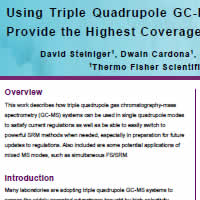Resumo do Pôster:
1. Introduction
Many laboratories are adopting triple quadrupole GC-MS systems to access the widely accepted advantages brought by high-selectivity detection of target analytes. However, while the advantages of MS/MS scan modes, particularly SRM, are well documented, some regulated methods such as EPA 8270 do not permit use of triple quadrupole GC-MS systems. Laboratories that are accredited for these “prescriptive” regulated methods are then compelled to continue with current technology such as single quadrupole GC-MS instruments. These regulated methods prevent users becoming familiar with the latest technology so they are not able to use triple quadrupole technology unregulated sample analysis or special projects.
The versatility of a new GC-MS/MS system will be demonstrated in the various operational modes offered. The system enables truly simple operation whether the analyst chooses to use it in single or triple quadrupole mode. It also bridges the gap between single and triple quadrupole mode use within the same instrument to allow easy adoption of powerful MS/MS workflows when required. Using the instrument in single quadrupole GC-MS mode allows the analyst to continue running current instrument configuration and established methods. The integrated software walks the analyst through a step-by-step process to manage the transition to powerful, triple quadrupole methods.
2. Purpose
Demonstrate how a triple quadrupole GC-MS system can be used in single quadrupole modes.
3. Method
Methods were developed for semi-volatile organic compounds (SVOCs) and pesticides, and data is presented in full scan, SIM, SRM, and SRM/full scan modes.
4. Results and Discussion
Full Scan Data: SVOC calibration curves were generated from 1 to 200 mg/mL in methylene chloride and analyzed on the triple quadrupole GC-MS/MS and single quadrupole GC-MS instruments. A comparison of the %RSDs of the curves is shown in Figure 1. A comparison of 10 replicate injections at 1 mg/mL is displayed in Figure 2.
SIM was used for the analysis of tetrahydrocannabinol (THC) in urine samples. THC, THC-OH, and THCCOOH were extracted and derivatized for this study. Concentrations used were the cutoff value (15 ng/mL), 125% of the cutoff value (18.75 ng/mL), and 40% of the cutoff value (6 ng/mL). Table 1 shows the %RSDs of 10 replicate analyses of the three concentrations.
TABLE 1. %RSD of 10 replicates THC samples – Triple Q vs Single Q.
|
Triple Q |
Single Q |
Triple Q |
Single Q |
Triple Q |
Single Q |
|
Cutoff |
Cutoff |
125% Cutoff |
125% Cutoff |
40% Cutoff |
40% Cutoff |
|
15 ng/mL |
15 ng/mL |
18.75 ng/mL |
18.75 ng/mL |
6 ng/mL |
6 ng/mL |
THC |
2.8 |
5.8 |
4.6 |
3.9 |
9.4 |
2.4 |
THC-OH |
2.3 |
2.8 |
4.4 |
4.0 |
8.2 |
1.9 |
THC?COOH |
2.0 |
3.2 |
2.8 |
3.5 |
9.5 |
1.9 |
SRM Data: SVOC calibration standards were prepared in methylene chloride from 1 to 1000 ng/mL. Transitions and collision energies for SRM were determined and optimized using the AutoSRM function of the software. Curves using internal standards were generated. The linearity of the curves was >0.99 for all analysed compounds, and the %RSDs for the calibration curve for the triple and single quadrupole were very similar.
SRM/FS Data: A sample of fruit drink was extracted using the QuEChERS method of extraction and cleanup. The extract was concentrated 5 times, and then 147 pesticides were spiked into the extract to produce calibration curves from 1 ng/mL to 200 ng/mL. The calibration curves were constructed for both methods: SRM and alternating SRM/full scan for 147 pesticides. The linearity for most of the compounds was R2 > 0.98 for both methods of analysis. Ten replicates of a 1 ng/mL and 10 ng/mL standard in fruit juice extract were analyzed to determine the MDLs for the two instrument methods. A comparison of the MDLs of both methods show a slightly higher values with the full scan added to the instrument method, but very comparable.
5. Conclusion
The triple quadrupole GC/MS-MS system used in this work can be used as a single quadrupole instrument that provides additional triple quadrupole capabilities to any laboratory. Whether the application is full scan, SIM, SRM, or a combination of SRM and full scan, the triple quadrupole GC/MS-MS system produces sensitive, accurate results.
|

